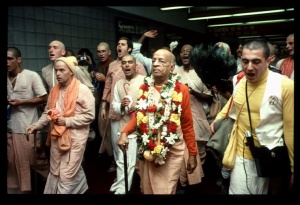CC Madhya 19.178

A.C. Bhaktivedanta Swami Prabhupada
TEXT 178
- prema vṛddhi-krame nāma—sneha, māna, praṇaya
- rāga, anurāga, bhāva, mahābhāva haya
SYNONYMS
prema — ecstatic love for God; vṛddhi-krame — in terms of progressive increase; nāma — named; sneha — affection; māna — abhorrence; praṇaya — love; rāga — attachment; anurāga — further attachment; bhāva — ecstasy; mahā-bhāva — great ecstasy; haya — are.
TRANSLATION
“The basic aspects of prema, when gradually increasing to different states, are affection, abhorrence, love, attachment, further attachment, ecstasy and great ecstasy.
PURPORT
In the Bhakti-rasāmṛta-sindhu, (3.2.84) sneha (affection) is described as follows:
- sāndraś citta-dravaṁ kurvan premā ‘sneha’ itīryate
- kṣaṇikasyāpi neha syād viśleṣasya sahiṣṇutā
“That aspect of prema in which the melting of the heart for the lover is concentrated is called sneha, or affection. The symptom of such affection is that the lover cannot for a moment remain without the association of the beloved.” A description of māna can be found in Madhya-līlā (Chapter Two, verse 66). Similarly, a description of praṇaya is also there. As far as rāga is concerned, the Bhakti-rasāmṛta-sindhu (3.2.87) says:
- snehaḥ sa rāgo yena syāt sukhaṁ duḥkham api sphuṭam
- tat-sambandha-lave ‘py atra prītiḥ prāṇa-vyayair api
“That stage at which affection for the beloved converts unhappiness into happiness is called rāga, or attachment. When one has such attachment for Kṛṣṇa, he can give up his own life to satisfy his beloved Kṛṣṇa.” Anurāga, bhāva and mahābhāva are described in the Sixth Chapter of the Madhya-līlā, verse 13. The purport to that verse explains adhirūḍha-mahābhāva.